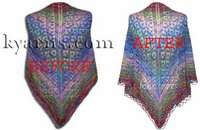I recently RE-blocked my Koigu Lace Shawl. The first time I did it, I did not use the wires. And I did not pin out the points on my crochet edging as much as I could have. It was my first shawl - and not really being a shawl wearer, I did not want a HUGE shawl. I blocked conservatively and I was very pleased with the results.
 A few weeks ago one of our customers was about to block her Koigu Lace Shawl. We were talking about how she should do it, and about how the edging could be blocked differently than mine was. We decided that she would pin out each point on the crocheted edging. And her results were amazing. (Aren't her colors wonderful too?)
A few weeks ago one of our customers was about to block her Koigu Lace Shawl. We were talking about how she should do it, and about how the edging could be blocked differently than mine was. We decided that she would pin out each point on the crocheted edging. And her results were amazing. (Aren't her colors wonderful too?)
As soon as I saw her shawl, I decided to reblock both the Koigu Lace Shawl, and the Charlotte's Web Shawl. As you can see, my results were dramatic as well.


RECIPE FOR BLOCKING
(NOTE: this technique can be followed for a number of fibers, but not all fibers. Always check your yarn label or ask someone at your local yarn shop for blocking recommendations.)
INGREDIENTS
1 knitted item to be blocked (ITBB) (shawl, sweater, scarf, etc.)
1 sink or basin filled with cool to lukewarm water
a pinch of Eucalan or Kookaburra Woolwash
3 large clean towels
1 blocking surface (a rug works well!)
a lot of pins
1 set of blocking wires (optional, but recommended!)
1 measuring tape or yard stick
INSTRUCTIONS
1) Fill basin with water. Add a pinch of Eucalan or Kookaburra. Gently agitate the water with your hands to distribute the soap.
2) Insert your ITBB. Some ITBBs have a tendency to float up on the surface (lace shawls).
3) Make sure your ITBB is completely immersed in the water. Leave for a couple of minutes, until all of the fiber has absorbed water.
4) Drain the basin and with your hands, gently press the water out of the ITBB. Caution: DO NOT WRING OR TWIST! If the soap you used requires rinsing, proceed to step 5. If not, proceed to step 6.
5) Fill basin again with clean water. Then drain basin and press water out of ITBB. Repeat this step until you feel soap is completely gone.
6) Gently lift ITBB and place on dry, clean towel. Roll up the towel. This will absorb any excess water.
7) Spread 2 clean, dry towels on your blocking surface. Thread the blocking wires through the edges of your ITBB, and using the tape measure, pin into the correct shape and size.
8) Let dry at least 24 hours, more if necessary.






No comments:
Post a Comment